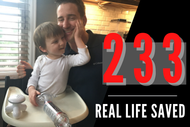Dechoker® Saves Autistic 3-Year-Old with Dysphagia
Sep 18th 2024
Choking is the leading cause of injury and death in children five years of age and younger. Unfortunately, children who are differently abled are often at a higher risk. For example, serious eating and swallowing disorders (Dysphagia) affect approximately 7 out of 10 children with autism. This statistic alone is cause for legitimate concern for families caring for their children on the spectrum.
The 233rd life saved by the Dechoker® was reported by Matt W., father of an autistic three-year-old who struggles with eating and swallowing. Matt followed the suggested first-aid protocol for choking to no avail, and when the procedures failed, he reached for the Dechoker®. He adds, "Add one to your lives saved counter. My autistic 3-year-old has a tough time eating, and he started choking and turning blue last night. I tried turning him 45 degrees down and hitting his upper back to no avail. I grabbed the Dechoker®, and it got it out immediately. Thank you!!! It saved him."
Choking Prevention Tips for Children with Autisim
Autism can affect children in how they experience and think about certain sensations. For example, it can affect feeding, eating, and swallowing functions. Children with autism can often struggle with social interaction, communication, sensory/motor function, behavior, and while eating, they can struggle with certain foods and textures.
Dechoker® has complied a few tips that can reduce the risk of choking incidents. We aim to give guidance to help parents and caregivers of child with autism who have specific feeding and eating issues:
- Keep a food diary of what the child usually eats, what they like to eat the most, when and how much they ate, and where they ate it.
- Establish a scheduled eating routine and make a visual chart, so the child knows what snack/meal is next.
- Supervise all snacks and mealtimes and maintain good examples of safe eating habits for your child. No walking, running, or playing while eating.
- Cut high-risk foods into smaller pieces. Some foods that are common choking hazards include hot dogs, raw vegetables, nuts, chunks of meat or cheese, round, firm foods that can act as a "plug," peanut butter on soft bread, and marshmallows.
- Learn first aid for choking and CPR.
What to Do If Choking First Aid Doesn't Work
Doctors and speech pathologists play an integral role in managing and addressing the chronic swallowing disorders typically present in children with autism, and can teach the children, families, and caregivers how to eat safely.
While these medical professionals can warn of the choking risks and possible outcomes like aspiration pneumonia (when food particles get caught or pulled into the trachea), the actual day-to-day risks of choking events still need to be managed.
Common care standards are a combination of back slaps and abdominal thrusts, also known as the Heimlich maneuver. Learning and knowing first-aid for choking is a must, but we also suggest having a Dechoker® nearby if these protocols fail. When someone chokes, time is of the essence and brain damage can occur in just 7-8 minutes. Unfortunately, first responders take on average 11 minutes to arrive to the scene.
We believe that any family with a person at a high risk of choking should add the Dechoker® into their first aid kit. Made in sizes for toddlers, children, and adults, this innovative suction device can clear a choking victim's airway in just seconds. It's straightforward to use, and it can be used on anyone regardless of other health conditions.

